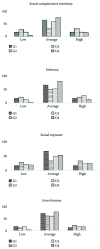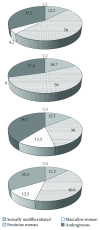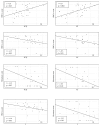Are Psychosocial Consequences of Obesity and Hyperandrogenism Present in Adolescent Girls with Polycystic Ovary Syndrome?
- PMID: 30147723
- PMCID: PMC6083491
- DOI: 10.1155/2018/3269618
Are Psychosocial Consequences of Obesity and Hyperandrogenism Present in Adolescent Girls with Polycystic Ovary Syndrome?
Abstract
Study objective: The objective of this study was to evaluate whether body weight status and clinical hyperandrogenism may influence social competencies and psychological gender features in adolescent girls.
Design and participants: In 104 adolescent girls, psychological gender inventory (PGI) and social competencies questionnaire (SCQ) (assessing social abilities in three aspects: intimacy (I), social exposure (SE), and assertiveness (AS)) were performed. Subjects were divided into four subgroups: G1-24 nonobese girls without hyperandrogenism, G2-18 obese girls without hyperandrogenism, G3-30 nonobese hyperandrogenic girls, and G4-32 obese girls with hyperandrogenism.
Results: There were no significant differences in all parts of SCQ and PGI between the study and control groups. The feminine woman type dominated in all groups; in G3 and G4, masculine woman type appeared more often than in G1 and G2 (13.3% and 12.5% versus 4.0% and 0.0%, resp.). In G4, positive relationship between BMI z-score and SCQ (r = 0.4, p = 0.03) was found. In G1, the relationship was opposite (r = -0.5, p = 0.03). Hirsutism correlated negatively with SCQ (r = -0.5, p = 0.02), I (r = -0.5, p = 0.02), and AS (r = -0.5, p = 0.02) only in G1; in other groups, this relationship was insignificant. In G4, higher testosterone level was associated with lower SCQ (r = -0.5, p = 0.008) and AS (r = -0.5, p = 0.003). In G2, testosterone concentration correlated positively with SCQ (r = 0.6, p = 0.01), SE (r = 0.5, p = 0.02), and AS (r = 0.6, p = 0.02).
Conclusion: In adolescent girls, neither body weight nor clinical features of hyperandrogenism seem to be the source of evaluated disorders in psychological functioning.
Figures




Similar articles
-
Social abilities and gender roles in adolescent girls with polycystic ovary syndrome - a pilot study.Endokrynol Pol. 2014;65(3):189-94. doi: 10.5603/EP.2014.0026. Endokrynol Pol. 2014. PMID: 24971919
-
Serum hormone levels and anthropometric characteristics in girls with hyperandrogenism.Medicina (Kaunas). 2005;41(4):305-12. Medicina (Kaunas). 2005. PMID: 15864003
-
The association of obesity and hyperandrogenemia during the pubertal transition in girls: obesity as a potential factor in the genesis of postpubertal hyperandrogenism.J Clin Endocrinol Metab. 2006 May;91(5):1714-22. doi: 10.1210/jc.2005-1852. Epub 2006 Feb 21. J Clin Endocrinol Metab. 2006. PMID: 16492701
-
Polycystic ovary syndrome.Endocrinol Metab Clin North Am. 1997 Dec;26(4):893-912. doi: 10.1016/s0889-8529(05)70286-3. Endocrinol Metab Clin North Am. 1997. PMID: 9429864 Review.
-
Acne, hirsutism, and alopecia in adolescent girls. Clinical expressions of androgen excess.Endocrinol Metab Clin North Am. 1993 Sep;22(3):507-32. Endocrinol Metab Clin North Am. 1993. PMID: 8243445 Review.
Cited by
-
Polycystic Ovary Syndrome in adolescents: a qualitative study.Psychol Res Behav Manag. 2019 Aug 22;12:715-723. doi: 10.2147/PRBM.S207727. eCollection 2019. Psychol Res Behav Manag. 2019. PMID: 31686927 Free PMC article.
References
-
- Forys-Dworniczak E., Zachurzok A., Pasztak-Opilka A., Malecka-Tendera E. Health-related quality of life and gender roles in adolescent girls with polycystic ovary syndrome: a systematic review. Pediatric Endocrinology. 2017;16(2):49–54. doi: 10.18544/ep-01.16.02.1670. - DOI
LinkOut - more resources
Full Text Sources
Other Literature Sources
Research Materials

